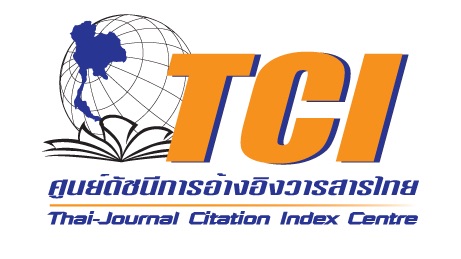The Creation of an Artificial Dance: Apsara Dance (Tae We) Ta Muen Thom Dance to Cultural Tourism
Keywords:
Choreography, Apsara, Prasat Ta Muen ThomAbstract
“Apsara Dance (Tae We) Ta Muen Thom Dance to Cultural Tourism” was the performing arts grown from ancient Khmer stone sculpture of Apsara (a celestial maiden in Hindu culture) found inside Angkor Ta Muen Thom, Ta Miang subdistrict, Phanom Dong Rak district, Surin province. Data was collected as the result of the literature review and field trip via the use of a survey, an observation, and an interview. Data Triangulation was used to synthesize the data correctness to create the choreography which integrated techniques between the creator's imagination and five concepts of choreography: 1) story, 2) dance pose, 3) garment, 4) music, and 5) dance pattern. To create this, the creator had to be the one who was skillful and keen on Thai dance art. The creative process consisted of three stages: 1) drawing an outline, 2) creating performance, and 3) performing and evaluating audiences’ attitudes. The result of the study indicated that dance poses in (Tae We) Apsara Ta Muen Thom Dance were developed based on 108 Shiva’s cosmic dance recorded in the Nataya Shastra written by Bharatamuni. These dance poses were creatively combined both Thai classical and new dance poses blended with harmonic rhythm. The dance paid attention to Apsara beauty and human trust to female deity in Brahman-Hindu belief – the one who ordained peacefulness to mankind. This dance was the creative experimental performance, inspired by historical evidence from the folk philosopher’s vision on Angkor Ta Muen Thom, to enhance cultural tourism. The performance reflected the intrinsic value, belief, and respect, and faithfulness to the deity. It was an uncut relationship that adjusted itself to the present context. Also, the performance could be a good media for urging tourists to realize the importance of historical sight-seeing.
References
กีรติ บุญเจือ. (2522). ชุดปัญหาปรัชญา ปรัชญาศิลปะ. กรุงเทพฯ : ไทยวัฒนาพานิช.
ปแฎงมหาบุญเรือง คัชมาย์. (2551). กลุ่มปราสาทตาเมือน. พิมพ์ครั้งที่ 1 สุรินทร์ : มหาวิทยาลัยราชภัฏสุรินทร์.
พิญชา สุ่มจินดา. (2560).“ภาพงานพระเมรุสมเด็จพระเพทราชาที่ค้นพบใหม่กับข้อวินิจฉัยเบื้องต้น,” ศิลปวัฒนธรรม 38 (มกราคม): 99–90.
พีรพงศ์ เสนไสย. (2546). นาฏยประดิษฐ์. มหาสารคาม : มหาวิทยาลัยมหาสารคาม.
สุภัทรดิศ ดิศกุล. (2539). ศิลปะขอม. กรุงเทพฯ: คุรุสภา.
สุรพล, วิรุฬห์รักษ์. (2547). หลักการแสดงนาฏยศิลป์ปริทรรศน์. กรุงเทพฯ:จุฬาลงกรณมหาวิทยาลัย.
ศิริพร สุเมธารัตน์. (2554). ประวัติศาสตร์ท้องถิ่นเมืองสุรินทร์. พิมพ์ครั้งที่ 3 กรุงเทพฯ: โอเดียนสโตร์.
ศิริมงคล นาฏยกุล. (2557). นาฏยศิลป์ตะวันตกปริทัศน์. ขอนแก่น: หจก. โรงพิมพ์คลังนานาวิทยา.
ศานติ ภักดีคำ. (2557). ครุฑ. อมรินทร์: กรุงเทพมหานคร.
อนงค์ หนูแป้น. (2535). การศึกษากลุ่มปราสาท. วิทยานิพนธ์ หลักสูตรปริญญาศิลปศาสตร มหาบัณฑิต สาขาวิชาโบราณคดีสมัยประวัติศาสตร์ มหาวิทยาลัยศิลปากร.
อุไร นาลิวันรัตน์. (2522). นางอัปสรในวรรณคดีสันสกฤต. วิทยานิพนธ์ หลักสูตรปริญญาอักษร.
Downloads
Published
How to Cite
Issue
Section
License

This work is licensed under a Creative Commons Attribution-NonCommercial-NoDerivatives 4.0 International License.







